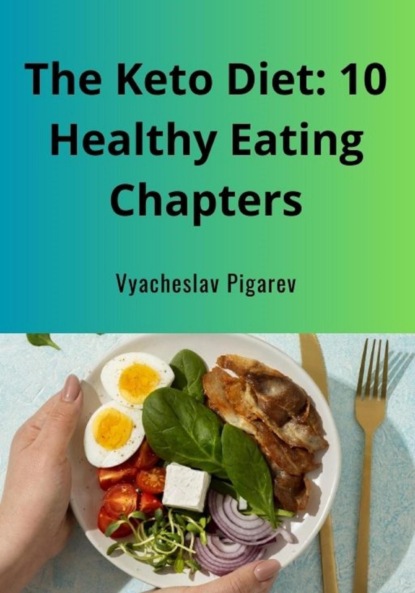По всем вопросам обращайтесь на: info@litportal.ru
(©) 2003-2024.
✖
The Keto Diet: 10 Healthy Eating Chapters
Настройки чтения
Размер шрифта
Высота строк
Поля
The Keto Diet: 10 Healthy Eating Chapters
Вячеслав Пигарев
Divided into ten chapters, each devoted to a different aspect of the keto diet, this book serves as a valuable resource for beginners and experienced ketogenic dieters alike. With an emphasis on nutritious, flavorful and readily available ingredients, the book empowers readers to create mouth-watering meals that meet their health and wellness goals.The Litres site administration is not responsible for the information provided. There may be medical contraindications, a specialist consultation is necessary.
Вячеслав Пигарев
The Keto Diet: 10 Healthy Eating Chapters
Chapter 1: Introduction to the Keto Diet
What is a keto diet?
A ketogenic diet is an eating regimen that includes high amounts of fat, low to moderate amounts of protein, and very few carbohydrates. The keto diet is usually rich in foods such as butter, cheese, eggs, meat, nuts, oils, seafood, and seeds. It leaves little room for fruits, vegetables, grains, potatoes, sweets, and other carbohydrate-rich foods.
Although there are variations of the ketogenic diet, they all have the common goal of limiting carbohydrate intake. A typical ketogenic diet plan aims to get about five percent of calories from carbohydrates, 20 percent from protein and 75 percent from dietary fats. With a ketogenic diet of 2,000 calories per day – this equates to about 100 calories (25 grams) of carbohydrates, 400 calories (100 grams) of protein and 1,500 calories (167 grams) of dietary fat. Although some ketogenic diets, depending on their phase and caloric needs, may include up to 70 grams of carbs per day, 50 grams or less is the typical maximum intake goal.
By limiting carbs and controlling protein intake, the ketogenic diet aims to bring your body into a state of nutritional ketosis, a metabolic process that increases the production of ketones, which are produced by the liver and can be used as the body's primary source of energy. When we are not in ketosis, glucose (derived from carbohydrates) is our body's main source of energy.
What are ketones?
Ketones are water-soluble byproducts of fat breakdown in the liver. Ketone production is a normal bodily process that occurs regularly, including during sleep. Our liver always produces some number of ketones, but when our daily carbohydrate and protein intake is high enough, our ketone production remains relatively low.
How do dietary carbohydrates provide energy?
There are two kinds of carbohydrates: those that we can digest and dietary fiber that we cannot digest. When we consume digestible carbohydrates, our bodies break them down into their simplest forms: monosaccharides, fructose, galactose and glucose. Most of the carbohydrates we consume are eventually converted to glucose because glucose is the most common monosaccharide found in nature, and our body can convert fructose and galactose to glucose.
Glucose is crucial to our survival. A constant supply of glucose circulates in our bloodstream, which, with the help of insulin, makes energy available. Glucose stores are also stored in the liver and muscles in the form of glycogen. We usually have about a day's supply of glucose in the form of glycogen. When blood glucose levels are low, the liver breaks down glycogen to raise blood glucose levels. When we need energy for muscle contraction and blood glucose levels are low, our muscles break down their glycogen stores.
How do we get energy without dietary carbohydrates?
When we eat, exercise, sit or sleep, our bodies are busy controlling and providing our energy supply. And, when needed, our bodies produce the energy they need from non-carbohydrate sources.
One of the ways our bodies do this is through gluconeogenesis, a process that uses non-carbohydrate substances to produce glucose. We can also use protein and fat for energy. For example, the amino acids in the proteins we consume can be used during gluconeogenesis to produce glucose. And triglycerides, the type of fat we store in adipose tissue, can be broken down through lipolysis and used to trigger a sequence of events that generate ketones when our glycogen stores run out.
In short, by relying less on carbohydrates for energy, you increase ketone production. Although the liver always produces some number of ketones for energy from fat, the more the body switches to fat as an energy source, the more ketones production increases. But eating too much protein can reduce ketone production, making it difficult to achieve and maintain ketosis, so a true ketogenic diet has restrictions on protein intake as well as carbohydrates.
How does the keto diet work?
The keto diet works because when you limit dietary carbohydrates – your body's main source of energy – your body breaks down stored fat and creates ketones, which are used for energy instead. However, calories still matter. If you overeat on protein and fats, and the total number of calories exceeds what your body burns, you still won't see weight loss. Foods high in fat and protein (the foundation of this diet) increase satiety, so usually your total calorie intake is lower than what your body burns, resulting in weight loss.
The rapid weight loss that people experience after the keto diet is also partly due to water weight loss – your body stores carbs with water, so when you use up your carbohydrate stores, you lose water weight. Most people just don't burn enough calories to lose more than one pound of fat per week, so the results of the keto diet add up to more than that, probably because of water weight loss.
Weight regains is extremely common on the keto diet because most people cannot maintain this diet for long periods of time, and after reintroducing carbs, people often see an increase in weight and a decrease in keto diet results.
What foods do you need to remove from your diet?
Here's what you should avoid on the keto diet – foods that are high in carbohydrates, both sweet and starchy.
Foods to stay away from include:
Bread, tortillas, muffins, bagels, pancakes
Pasta and rice
Cereal
Cakes, cookies, and other pastries
Sugar and anything made with sugar
Most fruits and fruit juices
Also, avoid or limit highly processed foods and instead fill your diet with our recommended keto-friendly options.
Chapter 2: The Basics of Keto Cooking
How do I make a menu for the keto diet?
Tips before you start your meal plan:
1. Calculate your calories and adjust your plan
Calories are something you need to consider on a ketogenic diet. While some people can get away with the "eat full" philosophy, it doesn't work for most people. There are plenty of hormone, endocrine and deficiency issues that we still need to take into account.
Adjust the plan to suit your needs. This meal plan averages 1,538 calories, 120 g of fat, 24 g of net carbs and 83 g of protein for 2 weeks. If this differs from your macros, consider adjusting the plan to fit your needs.
To increase caloric intake. If you need to increase your fat intake on the plan, add extra butter, cream, cheese, or cream cheese to your recipes; or have coffee and cream at your first meal. If you need to increase the amount of protein, simply increase the amount of lean meat that is added to the recipe.
To reduce calories. If you need to reduce your fat intake, remove butter, cream, cheese or cream cheese from the plan. Similarly, if you need to reduce your protein intake in the plan, remove some lean meat added to the recipes.
2. Prepare ahead of time.
Be prepared, make sure you eat what you need to be full, and make sure you are satisfied with what you eat. If you have to force yourself to eat something, it won't work out in the end. This is just a guide on how you can eat on a ketogenic diet, so you can change what you eat!
Set a start date. Be realistic with yourself and set a date when you want to start. Be sure to have your shopping ready to start so there are no missed ingredients or surprises. Promise yourself to follow the plan completely and stick to the start date you set.
Get your refrigerator and pantry in order. When temptation comes up every time you open the cupboard, you may find it difficult to stick to your newfound dietary preferences. Ketosis is a process that happens in your body. You can't just break your diet. If you do, it can stall progress for up to a week before your body goes back into ketosis and starts burning fat again.
If possible, remove all high-carbohydrate foods and tempting meals from your kitchen to stay on track. You will likely need to buy some new keto ingredients for the plan, so be sure to read ahead and stock your refrigerator as needed.
3. Understanding Keto Flu.
Keto flu is a combination of symptoms that occur when you first switch to a low-carb diet. You may experience dizziness, headaches, fatigue, cramps, nausea, or fatigue for a few days after starting a keto diet. Don't worry, this is normal and can be dealt with.
The keto diet is also diuretic and can cause dehydration. With extra urination, you will deplete both the water in your body and your electrolytes faster. Your T3 (thyroid hormone) will decrease slightly and your cortisol levels will increase. Although keto flu affects everyone differently, you may feel some of these symptoms, but you can do something to reduce the symptoms or stop them completely.
Simply increase your water intake (or drink other keto-friendly drinks) and increase your electrolytes. You can use electrolyte supplements or take multivitamins that include potassium and magnesium. Also, add salt to your food or water to help.
4. Stop mindlessly snacking
Вячеслав Пигарев
Divided into ten chapters, each devoted to a different aspect of the keto diet, this book serves as a valuable resource for beginners and experienced ketogenic dieters alike. With an emphasis on nutritious, flavorful and readily available ingredients, the book empowers readers to create mouth-watering meals that meet their health and wellness goals.The Litres site administration is not responsible for the information provided. There may be medical contraindications, a specialist consultation is necessary.
Вячеслав Пигарев
The Keto Diet: 10 Healthy Eating Chapters
Chapter 1: Introduction to the Keto Diet
What is a keto diet?
A ketogenic diet is an eating regimen that includes high amounts of fat, low to moderate amounts of protein, and very few carbohydrates. The keto diet is usually rich in foods such as butter, cheese, eggs, meat, nuts, oils, seafood, and seeds. It leaves little room for fruits, vegetables, grains, potatoes, sweets, and other carbohydrate-rich foods.
Although there are variations of the ketogenic diet, they all have the common goal of limiting carbohydrate intake. A typical ketogenic diet plan aims to get about five percent of calories from carbohydrates, 20 percent from protein and 75 percent from dietary fats. With a ketogenic diet of 2,000 calories per day – this equates to about 100 calories (25 grams) of carbohydrates, 400 calories (100 grams) of protein and 1,500 calories (167 grams) of dietary fat. Although some ketogenic diets, depending on their phase and caloric needs, may include up to 70 grams of carbs per day, 50 grams or less is the typical maximum intake goal.
By limiting carbs and controlling protein intake, the ketogenic diet aims to bring your body into a state of nutritional ketosis, a metabolic process that increases the production of ketones, which are produced by the liver and can be used as the body's primary source of energy. When we are not in ketosis, glucose (derived from carbohydrates) is our body's main source of energy.
What are ketones?
Ketones are water-soluble byproducts of fat breakdown in the liver. Ketone production is a normal bodily process that occurs regularly, including during sleep. Our liver always produces some number of ketones, but when our daily carbohydrate and protein intake is high enough, our ketone production remains relatively low.
How do dietary carbohydrates provide energy?
There are two kinds of carbohydrates: those that we can digest and dietary fiber that we cannot digest. When we consume digestible carbohydrates, our bodies break them down into their simplest forms: monosaccharides, fructose, galactose and glucose. Most of the carbohydrates we consume are eventually converted to glucose because glucose is the most common monosaccharide found in nature, and our body can convert fructose and galactose to glucose.
Glucose is crucial to our survival. A constant supply of glucose circulates in our bloodstream, which, with the help of insulin, makes energy available. Glucose stores are also stored in the liver and muscles in the form of glycogen. We usually have about a day's supply of glucose in the form of glycogen. When blood glucose levels are low, the liver breaks down glycogen to raise blood glucose levels. When we need energy for muscle contraction and blood glucose levels are low, our muscles break down their glycogen stores.
How do we get energy without dietary carbohydrates?
When we eat, exercise, sit or sleep, our bodies are busy controlling and providing our energy supply. And, when needed, our bodies produce the energy they need from non-carbohydrate sources.
One of the ways our bodies do this is through gluconeogenesis, a process that uses non-carbohydrate substances to produce glucose. We can also use protein and fat for energy. For example, the amino acids in the proteins we consume can be used during gluconeogenesis to produce glucose. And triglycerides, the type of fat we store in adipose tissue, can be broken down through lipolysis and used to trigger a sequence of events that generate ketones when our glycogen stores run out.
In short, by relying less on carbohydrates for energy, you increase ketone production. Although the liver always produces some number of ketones for energy from fat, the more the body switches to fat as an energy source, the more ketones production increases. But eating too much protein can reduce ketone production, making it difficult to achieve and maintain ketosis, so a true ketogenic diet has restrictions on protein intake as well as carbohydrates.
How does the keto diet work?
The keto diet works because when you limit dietary carbohydrates – your body's main source of energy – your body breaks down stored fat and creates ketones, which are used for energy instead. However, calories still matter. If you overeat on protein and fats, and the total number of calories exceeds what your body burns, you still won't see weight loss. Foods high in fat and protein (the foundation of this diet) increase satiety, so usually your total calorie intake is lower than what your body burns, resulting in weight loss.
The rapid weight loss that people experience after the keto diet is also partly due to water weight loss – your body stores carbs with water, so when you use up your carbohydrate stores, you lose water weight. Most people just don't burn enough calories to lose more than one pound of fat per week, so the results of the keto diet add up to more than that, probably because of water weight loss.
Weight regains is extremely common on the keto diet because most people cannot maintain this diet for long periods of time, and after reintroducing carbs, people often see an increase in weight and a decrease in keto diet results.
What foods do you need to remove from your diet?
Here's what you should avoid on the keto diet – foods that are high in carbohydrates, both sweet and starchy.
Foods to stay away from include:
Bread, tortillas, muffins, bagels, pancakes
Pasta and rice
Cereal
Cakes, cookies, and other pastries
Sugar and anything made with sugar
Most fruits and fruit juices
Also, avoid or limit highly processed foods and instead fill your diet with our recommended keto-friendly options.
Chapter 2: The Basics of Keto Cooking
How do I make a menu for the keto diet?
Tips before you start your meal plan:
1. Calculate your calories and adjust your plan
Calories are something you need to consider on a ketogenic diet. While some people can get away with the "eat full" philosophy, it doesn't work for most people. There are plenty of hormone, endocrine and deficiency issues that we still need to take into account.
Adjust the plan to suit your needs. This meal plan averages 1,538 calories, 120 g of fat, 24 g of net carbs and 83 g of protein for 2 weeks. If this differs from your macros, consider adjusting the plan to fit your needs.
To increase caloric intake. If you need to increase your fat intake on the plan, add extra butter, cream, cheese, or cream cheese to your recipes; or have coffee and cream at your first meal. If you need to increase the amount of protein, simply increase the amount of lean meat that is added to the recipe.
To reduce calories. If you need to reduce your fat intake, remove butter, cream, cheese or cream cheese from the plan. Similarly, if you need to reduce your protein intake in the plan, remove some lean meat added to the recipes.
2. Prepare ahead of time.
Be prepared, make sure you eat what you need to be full, and make sure you are satisfied with what you eat. If you have to force yourself to eat something, it won't work out in the end. This is just a guide on how you can eat on a ketogenic diet, so you can change what you eat!
Set a start date. Be realistic with yourself and set a date when you want to start. Be sure to have your shopping ready to start so there are no missed ingredients or surprises. Promise yourself to follow the plan completely and stick to the start date you set.
Get your refrigerator and pantry in order. When temptation comes up every time you open the cupboard, you may find it difficult to stick to your newfound dietary preferences. Ketosis is a process that happens in your body. You can't just break your diet. If you do, it can stall progress for up to a week before your body goes back into ketosis and starts burning fat again.
If possible, remove all high-carbohydrate foods and tempting meals from your kitchen to stay on track. You will likely need to buy some new keto ingredients for the plan, so be sure to read ahead and stock your refrigerator as needed.
3. Understanding Keto Flu.
Keto flu is a combination of symptoms that occur when you first switch to a low-carb diet. You may experience dizziness, headaches, fatigue, cramps, nausea, or fatigue for a few days after starting a keto diet. Don't worry, this is normal and can be dealt with.
The keto diet is also diuretic and can cause dehydration. With extra urination, you will deplete both the water in your body and your electrolytes faster. Your T3 (thyroid hormone) will decrease slightly and your cortisol levels will increase. Although keto flu affects everyone differently, you may feel some of these symptoms, but you can do something to reduce the symptoms or stop them completely.
Simply increase your water intake (or drink other keto-friendly drinks) and increase your electrolytes. You can use electrolyte supplements or take multivitamins that include potassium and magnesium. Also, add salt to your food or water to help.
4. Stop mindlessly snacking

















